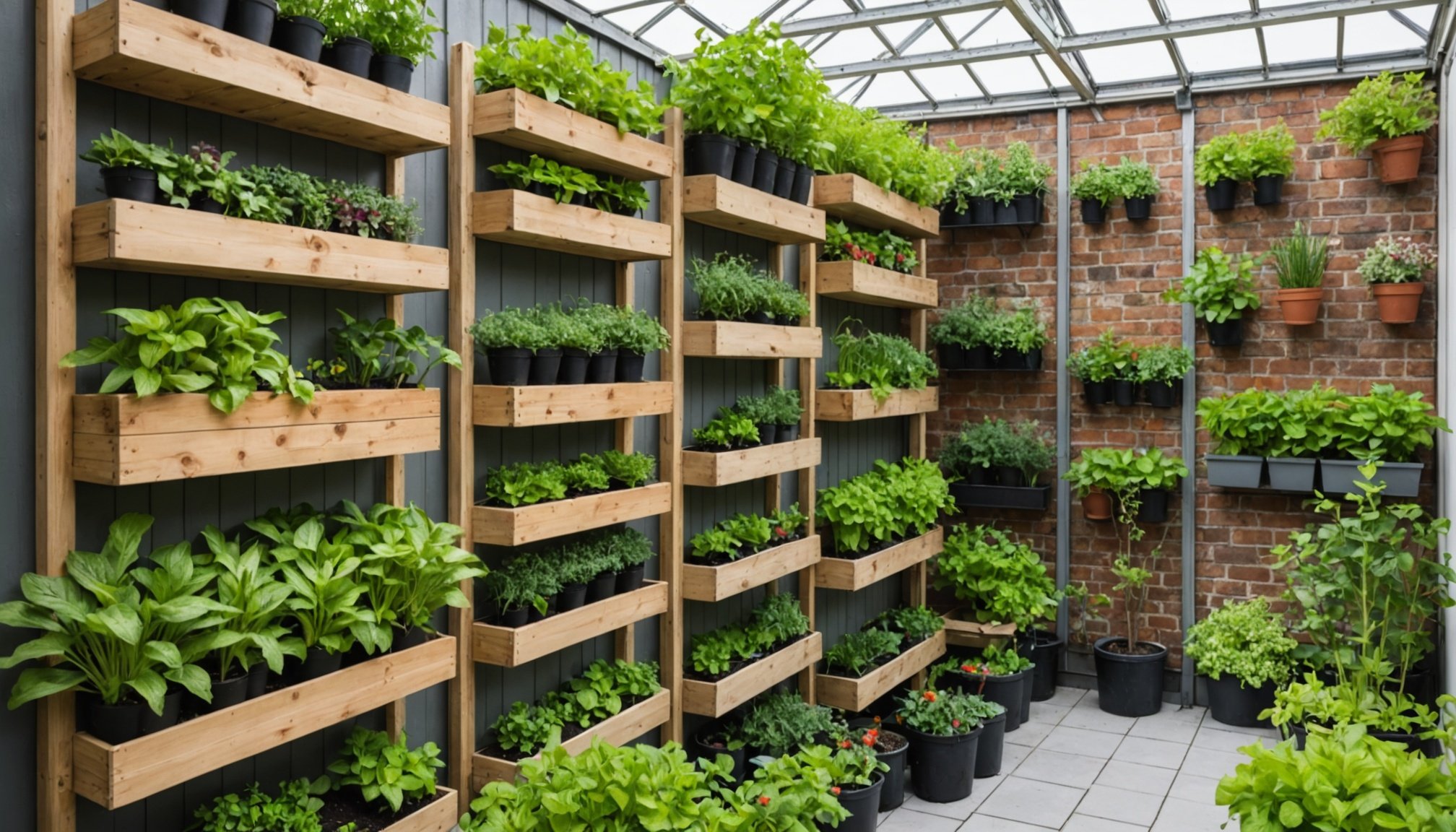Maximizing Vertical Spaces: Top Strategies for Urban Gardening Success in the UK
In the bustling urban landscapes of the UK, where space is often at a premium, the art of vertical gardening has become a game-changer for those eager to bring a touch of greenery into their lives. Whether you have a small balcony, a compact courtyard, or even just a wall in your backyard, vertical gardening offers a plethora of creative and practical solutions to maximize your space. Here’s a comprehensive guide to help you get started and make the most out of your urban garden.
Assessing and Planning Your Space
Before diving into the world of vertical gardening, it’s crucial to assess and plan your space carefully. Here are some key steps to consider:
Sujet a lire : Discover the Best Companion Plants for Growing Apple Trees in South-East UK!
Measure and Map Your Space
Take precise measurements of your garden area, including the dimensions of any walls, balconies, or existing planters. This will help you make informed decisions about what you can fit and where[2].
Create a Budget and Design Plan
Develop a budget and stick to it. Sketch out a garden plan to visualize how your space will look. This step is essential for ensuring that your purchases align with your vision and financial constraints[2].
Cela peut vous intéresser : Unlocking the Secrets: Effective Strategies to Enhance Crop Rotation Advantages in Your UK Garden
Consider the Sunlight and Wind
Understand the sunlight and wind patterns in your garden. For example, south-facing balconies are ideal for sun-loving plants like lavender and succulents, while north-facing areas are better suited for shade-tolerant plants like ferns and ivy[4].
Vertical Gardening Solutions
Vertical gardening is all about making the most of your available space by growing plants upwards. Here are some innovative solutions to consider:
Hanging Baskets and Wall Planters
Hanging baskets and wall planters are excellent for adding greenery without taking up floor space. These can be used to grow a variety of plants, from flowers and herbs to vegetables and moss[2][3][4].
Stackable Planters
Stackable planters, such as the Stackable Terracotta Herb Planter, are perfect for small gardens and balconies. These planters allow you to grow multiple plants in a vertical format, making them highly space-efficient[2].
Living Wall Planters
Living wall planters, like those from Crocus, are made from recycled plastic and come in various sizes. They are easy to assemble and provide a lush, green wall that can be installed both indoors and outdoors[2].
Trellises and Ladder Planters
Trellises and ladder planters are great for supporting climbing plants and adding a rustic touch to your garden. The Habitat Wood Ladder Planter, for instance, is made from eco-friendly FSC-certified wood and features deep planting boxes and smart copper label holders[2].
Maximizing Space with Creative Design
To truly maximize your space, you need to think creatively about your garden design.
Layering and Multipurpose Furniture
Use tiered plant stands, shelves, or stacked pots to create layers in your garden. This not only maximizes space but also adds depth and visual interest. Consider multipurpose furniture like foldable tables and chairs or benches with built-in storage to keep your space functional[4].
Wind Protection
Incorporate windbreaks into your design to protect your plants from strong winds. Bamboo screens, trellises, sturdy planters, and glass or plexiglass barriers can all serve as effective windbreaks while enhancing the aesthetic of your garden[4].
Weight Considerations
Be mindful of the weight of your pots, planters, and other elements to avoid structural issues. Opt for lightweight materials like fiberglass or plastic planters to ensure your balcony or courtyard remains safe and stable[4].
Choosing the Right Plants
The success of your vertical garden depends significantly on the plants you choose.
Plants for Different Light Conditions
Select plants that are suitable for the amount of sunlight your garden receives. For example:
- South-facing areas: Lavender, geraniums, succulents
- North-facing areas: Ferns, hostas, ivy
- East or west-facing areas: Herbs, pelargoniums, begonias[4]
Year-Round Interest
Choose plants that provide year-round interest. For instance, long-lasting perennials like verbena bonariensis add height and can be contained in small areas, with flowers lasting from May through to the winter[5].
Practical Tips and Tools
Here are some practical tips and tools to help you get started with your vertical garden:
DIY Kits and Professional Installations
You can start with DIY kits or opt for professional installations, depending on your comfort level and the complexity of your project. Local garden specialists can provide valuable advice on climate-specific challenges and recommend the right plants for your region[3].
Essential Tools and Materials
Here are some essential tools and materials you might need:
- Planters and containers: Choose materials that are durable and suitable for outdoor use.
- Soil and nutrients: Ensure your plants have adequate soil, water, and nutrients to thrive.
- Watering system: Consider a drip irrigation system to make watering easier and more efficient.
- Supports: Use trellises, stakes, or other supports for climbing plants.
Benefits of Vertical Gardening
Vertical gardening offers a multitude of benefits beyond just maximizing space.
Aesthetic Appeal
Vertical gardens can significantly enhance the aesthetic appeal of your outdoor space. They add a touch of nature and can soften the edges of hard landscaping, creating a more inviting and peaceful environment[5].
Improved Air Quality and Energy Efficiency
Vertical gardens help improve air quality by absorbing pollutants and releasing oxygen. They also provide natural insulation, regulating indoor temperatures and reducing the need for artificial heating and cooling[3].
Mental Well-being
Bringing nature into urban environments through vertical gardening can boost mental well-being and reduce feelings of stress and anxiety[3].
Real-Life Examples and Success Stories
Here are a few real-life examples that illustrate the success of vertical gardening:
Courtyard Garden Design
In a courtyard garden designed by Harris Bugg Studio in Holland Park, London, the designers used vertical planting to create a connected kitchen-to-garden space. The compact footprint of the garden meant every detail was visible, focusing on simplicity in materials and plant choices. The use of concrete planters and minimalist planting created a stylish and classic look[5].
Balcony Garden Transformation
On a small balcony, using stackable terracotta herb planters and wall-mounted planters can transform the space into a lush, green retreat. This setup allows for a variety of plants to be grown vertically, freeing up floor space for seating or other uses[2][4].
Vertical gardening is a versatile and innovative way to bring greenery into urban spaces, even in the most confined areas. By assessing your space carefully, choosing the right plants, and using creative design solutions, you can create a thriving and beautiful garden that enhances both the aesthetic appeal and the functionality of your outdoor space.
Detailed Bullet Point List: Top Vertical Gardening Essentials
- Stackable Terracotta Herb Planter: Perfect for small gardens and balconies, this planter allows you to grow up to 15 different small plants in a vertical format[2].
- Living Wall Planters: Made from recycled plastic, these planters are easy to assemble and provide a lush, green wall that can be installed both indoors and outdoors[2].
- Habitat Wood Ladder Planter: Made from eco-friendly FSC-certified wood, this planter features deep planting boxes and smart copper label holders, ideal for growing herbs, fruit, and flowers[2].
- Trellises and Bamboo Screens: These serve as natural windbreaks and provide support for climbing plants, adding depth and visual interest to your garden[4].
- DIY Kits and Professional Installations: Options range from DIY kits to professional installations, allowing you to choose the best approach for your project[3].
Comprehensive Table: Comparing Vertical Gardening Solutions
| Solution | Description | Benefits | Suitable For |
|---|---|---|---|
| Stackable Terracotta Herb Planter | Stackable pots for growing herbs and small plants vertically | Space-saving, durable, easy to move | Small gardens, balconies |
| Living Wall Planters | Wall-mounted planters made from recycled plastic | Eco-friendly, versatile, attractive | Balconies, patios, conservatories |
| Habitat Wood Ladder Planter | Rustic ladder planter with deep planting boxes and copper label holders | Eco-friendly, high-quality, space-saving | Small spaces, balconies |
| Trellises and Bamboo Screens | Natural windbreaks and supports for climbing plants | Wind protection, adds depth and visual interest | All types of gardens |
| DIY Kits and Professional Installations | Options for self-installation or professional help | Flexible, climate-specific advice, professional expertise | All types of gardens |
Quotes from Experts
- “Vertical gardens are an innovative, space-saving solution for incorporating nature into modern living spaces. With benefits ranging from improved air quality to aesthetic appeal, they are a versatile option for any homeowner or business looking to make a positive environmental impact while beautifying their surroundings.”[3]
- “Don’t think that a courtyard garden can’t be full of plants. You just need to choose the right plants, ones that create drama and intrigue and the illusion of space.”[5]
- “In this courtyard we designed in Holland Park, London, we worked alongside interior designer Rose Uniacke to create a connected kitchen-to-garden space that was stylish and classic. The compact footprint of the garden meant that every detail is visible, which meant a laser-like focus on simplicity in materials and plant choices.”[5]
By embracing these strategies and tools, you can transform even the smallest urban space into a vibrant and thriving garden, enhancing your quality of life and the beauty of your surroundings.






